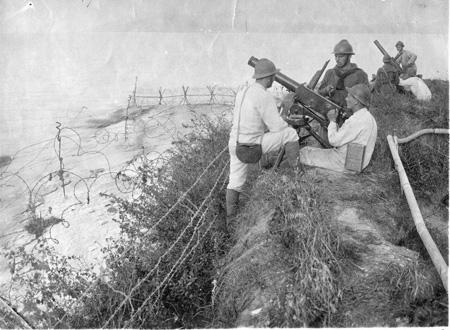With the undertaking of Premuda, conducted at the dawn of 10 1918 by the Rizzo commander with the MAS 15 and 21, Italy defined its superiority in the Adriatic towards Austria-Hungary and in fact sanctioned the defeat of the Central Empires . However, the activity of the Royal Navy was not limited solely to naval actions.
In addition to the effective use of maritime aviation (see documentary history of the Italian-Austrian Maritime War 1915-1918, USMM, maritime aviation during the war), the Navy's extensive contingent of the Army's operations on land fronts and especially on the Piave and in the defense of Venice. In these operations we want to remember the close collaboration between Marina and the Army on Lake Garda. At the beginning of the conflict there was a Command Flotilla del Garda with the task of directing the cruise and cruise service.
 Later, batteries of cannons were installed, including some large gauges (in particular a piece from 305 / 46 in Campagnola and one from 305 / 40 in Limone), sections of machine guns, telegraph, semaphore and exploration stations. In the 1917 the cruise service was reinforced with the MAS 12, 17, 20 and 203, and in the 1918 the Command Command of the Royal Navy on Lake Garda was established under the command of the frigate captain (later of a ship), Pietro Lodolo, who brought together all the lake activities under one direction, not least a submarine listening service. Three were the most important actions.
Later, batteries of cannons were installed, including some large gauges (in particular a piece from 305 / 46 in Campagnola and one from 305 / 40 in Limone), sections of machine guns, telegraph, semaphore and exploration stations. In the 1917 the cruise service was reinforced with the MAS 12, 17, 20 and 203, and in the 1918 the Command Command of the Royal Navy on Lake Garda was established under the command of the frigate captain (later of a ship), Pietro Lodolo, who brought together all the lake activities under one direction, not least a submarine listening service. Three were the most important actions.
The first, the night between 4 and 5 May 1918, was conducted with all four MASs and allowed a dumbbell of the XXIX Corps to reach enemy stations south of Torbole. By the second, at the beginning of July, four Bohemian informants from the 1a Armata were disembarked in a location between Torbole and Riva; the action was carried out by two MASe from a small, pre-arranged electric motorboat.
The third was the 3 November 1918, when with a joint action, using the MAS 12 and 203 with two platoons of sailors was occupied the port of Riva di Trento. "Grateful for the generous and effective [...] contest I am pleased to express a very lively praise to the Captain captain of the Lodolo vessel and to the staff [...] thus hastening the liberation of the never-Austrian side of our Garda", the commander of the 7a Armata, Lieutenant General Giulio Tassoni, following the occupation of Riva di Trento with the Comando Servizi, making the merit of our sailors in gray-green. (It is possible to deepen the subject by referring to Giuliano Manzari's article, "Mariners in Green Gray. The Navy's Cooperation with Army Operations on the Earth's Front", published in the September issue of 2008 of the Archives of the Historical Office of the Navy).

Source: Military Navy












